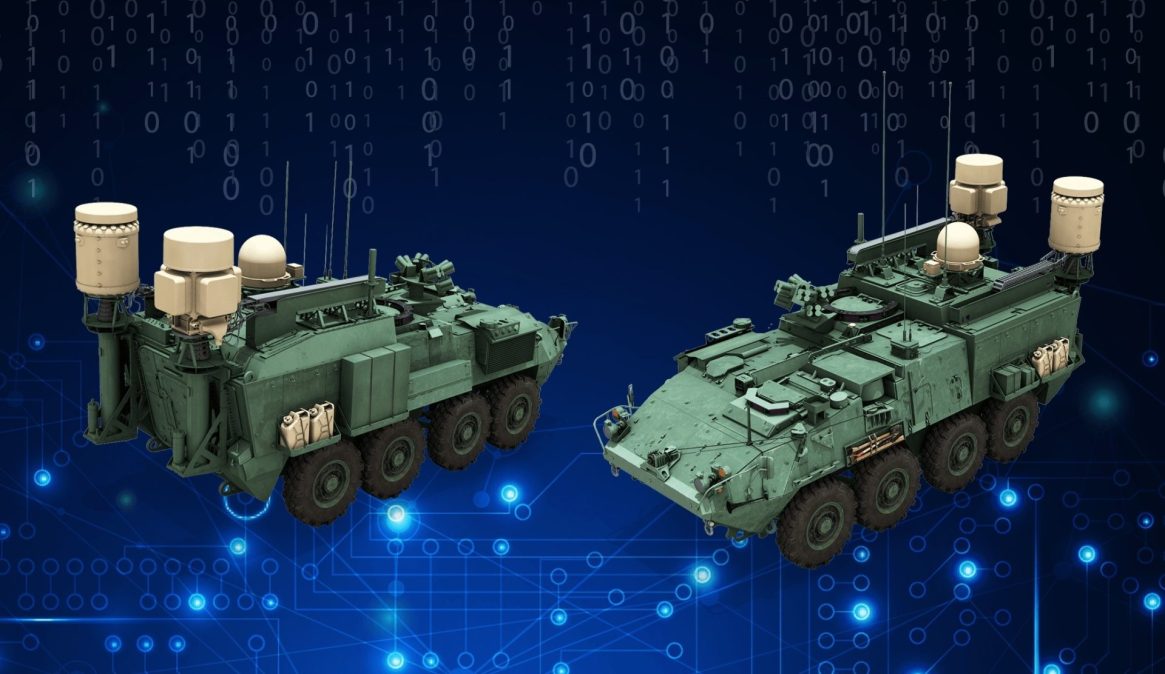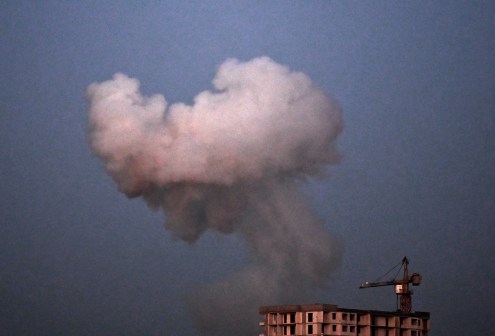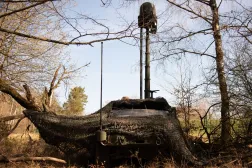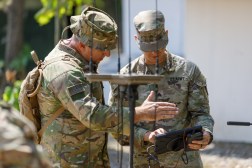Army examining best approach to fight electronic warfare at echelon

The Army is still determining how best to wage electronic warfare at echelon with various platforms.
A series of events will help officials determine what the concept of employment for EW will be at the division level and what programs of record will look like.
Those events included a tabletop exercise at Fort Eisenhower, Georgia, focused on how electronic warfare will be done at division and higher; an October Fires Symposium at Fort Sill, Oklahoma, examining how network, intelligence, cyber and EW will integrate into fires; a capabilities-based assessment for electromagnetic warfare conducted by the Cyber Capability Integration Directorate at the Cyber Center of Excellence in Augusta, Georgia, that will be completed over the next year; and a sensor-to-shooter event focused on challenges in the Indo-Pacific region and long-range precision fires at Fort Leavenworth, Kansas.
“We’re doing a deep dive on that now,” Col. Leslie Gorman, Army capability manager for electronic warfare, said in a recent interview regarding how the service is thinking about fighting electronic warfare at echelon and with what platforms. “I had a sit-down with some folks at the Pentagon yesterday. One of the things that came back was truly, what does that concept of employment look like at the division?”
She explained that the Cyber CDID event helped determine what exactly the forthcoming Terrestrial Layer System-Echelons Above Brigade (TLS-EAB) system will be.
TLS-EAB was initially designed as an integrated EW and signals intelligence system primarily for divisions, corps and Multi-Domain Task Forces to sense across greater ranges. Like its smaller, brigade counterpart, TLS-Brigade Combat Team, following experimentation and lessons from Europe, the Army has decided to split up the SIGINT and electronic warfare functions.
Given the EAB effort was less mature than the BCT variant at the time the decision to split the functions was made, officials have stated EAB will be the main component for defining and demonstrating an initial EW architecture and publishing the requests for information concerning the architecture, that will eventually deliver it back to the BCT version for integration.
“There’s been some interesting information that came out of that [tabletop event]. We also have another CONEMP we’re taking a look at from [the] C5ISR [Center] to help shape some discussions with the maneuvers at an upcoming tabletop exercise with them because I think that’s going to be very important,” Gorman said, using an acronym to refer to command, control, communications, computers, cyber, intelligence, surveillance and reconnaissance. “As we’re flushing out the requirements at echelon that we’re not only talking to fires, we’re also talking maneuvers. Because it’s ensuring that we’re incorporating our capabilities in a light infantry fight. Since we are an enabler, what does it look like to implement an EW sensor on a” robotic combat vehicle?
Officials are also looking at other capabilities that have been prototyped and used primarily at the brigade level to see if there’s applicability at division, namely, the Tactical Electronic Warfare System-Infantry Brigade Combat Team, or TEWS-I, which was initially a quick-reaction capability built by General Dynamics, providing a smaller system designed for infantry vehicles. It was a prototype activity to serve as a risk reduction and requirements pathfinder for the Army’s program of record, the Terrestrial Layer System-Brigade Combat Team (TLS-BCT) and has been used by units within the XVIII Airborne Corps.
Gorman noted that the service is looking at experimentation efforts next year to not only gain improvements for TEWS-I, but how that capability could potentially be a division asset.
The Army is still essentially in the requirements phase when it comes to the electronic warfare portion of TLS-BCT again, trying to figure out what makes the most sense going forward.
Gorman noted it could evolve to include more robust communications systems, deception capabilities or situational awareness tools. Moreover, while the Army is currently fielding the TLS Manpack — the first official program in decades for a dismounted electronic attack capability that soldiers can use to conduct direction finding with limited jamming on-the-move as well — for mobility, the service is looking at possibly bringing that into a vehicle mount with an amplifier for extended range, something that was conceived of initially within the original TLS family.
Constant feedback from units is also helping to inform future generations of the Manpack capability, Gorman said.
As the Army is continuing to work on the platform and capability side of the issue, fleshing out how they’ll be employed, the other critical parallel effort is moving out on EW-enabling capabilities to be able to plan and manage within the spectrum.
“It’s also ensuring that we address it as a system-of-systems approach … It’s going to be important to be able to ensure that these capabilities that we’re fielding, we’re able to communicate and C2 those systems, be able to also incorporate where the systems are on the battlefield and incorporate that into not only our EW plan of action via [the Electronic Warfare Planning and Management Tool], but then also think leveraging [the Spectrum Situational Awareness System] for the spectrum management, the [electromagnetic emission control], the [electronic protection] capabilities, to be able to also bring that information into fires for a more comprehensive, holistic, synchronized, non-lethal effect support to fires planning capability,” Gorman said.
EWPMT serves as a command-and-control planning capability that allows service members to visualize potential effects within the invisible spectrum and chart courses of action to prevent their forces and systems from being jammed during operations. The Army is embarking on the EWPMT “Next” effort, which involves shifting to the Tactical Assault Kit framework, where applications for situational awareness data and geospatial visualizations can be created for better joint and coalition integration.
The Spectrum Situational Awareness System (S2AS) is a new start in fiscal 2025 and is envisioned to be a commercial off-the-shelf solution that will provide sensing and visualization of what units look like in the spectrum and allow commanders to be able to sense and report in real-time their command post signatures, sources of electromagnetic interference — either from coalition partners or the enemy — and threat emissions.
Officials have described EWPMT as the glue that holds the electronic warfare architecture together, because if forces can’t see, understand and plan within the spectrum, jamming and sensing capabilities won’t be effective.
“We’re talking about this too, is like we have a lot of Manpacks coming out. We’re going to have to be able to ensure that those systems can be effectively C2’d and that missions can be planned at the optimal level at echelon, so that way everyone understands what’s going on their battlespace. I think that helps reduce potential adjacent unit RF interference or jamming,” Gorman said. “It’s also ensuring that our signatures that we’re emitting, that is also a part of our planning efforts and you have to do that with each and every EW emitter or an effector.”
The Army will begin embedding its requirements personnel with experimental units to create a direct feedback loop to inform the software developers for EWPMT in the program office. This will help the program office prioritize as the service is planning likely tranches of 12 improvements per quarter going forward in line with a holistic software modernization strategy for EWPMT Next.






